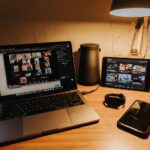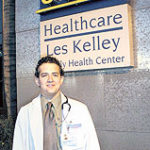‘The Movement and the Moment’ Focuses on AAS’ OriginsBy Yayoi Lena Winfrey, AAV Contributing Editor Bordering the exclusive neighborhood of Beverly Hills, the University of California at Los Angeles boasts a diverse campus. Out of 35,000 students, 40% are Asian or Asian American, thanks in part to the Asian American Studies Center, one of the oldest, largest and most comprehensive in the country. Attracting over 3,000 undergraduate and graduate students annually, the Center houses forty faculty members representing twenty-two departments and seventy different Asian American student groups. The Center occupies two of Campbell Hall’s three floors. Bulletin boards are plastered with flyers advertising everything from Chusoh (a Korean thanksgiving festival) to academic advisors available to guide students in exploring the program. Posted job openings list faculty positions as well as internships at Dreamworks Studios and Fox TV, making them uniquely L.A. Outside Director Don T. Nakanishi’s door, I study the 25th Anniversary Commemorative Mural of 1968 San Francisco State College. Often cited as the heart of early APA student unrest, the school and its rebels are credited with creating the concept of Asian American Studies [AAS]. At UCLA, it’s defined as an Interdepartmental Program promoting the study of Asian and Pacific Islander peoples in the U.S. According to Nakanishi, the Center “was started in 1969 by students, faculty and Asian community leaders who wanted to see AAS courses as well as…other things relating to the APA community here.” He notes that the Black power movement, student strikes and anti-war protests of the period played a role in helping to inspire and shape AAS. “No program in the country matches (ours),” he proclaims, adding that UCLA’s goes beyond traditional areas of literature and history to include urban planning, public health, film, education, law and medicine. Besides teaching courses, the Center also forges extensive relationships with community groups both locally and nationally–arts organizations, museums, civil rights groups, literary organizations, and other empowerment groups. “We’ve published 200 books in our history,” Nakanishi says, handing me a copy of Cross Currents, the Center’s news magazine edited by Glen Omatsu.
Director Don NakanishiBorn in East Los Angeles, Nakanishi graduated from Yale after studying political science on a full scholarship. While there, he got his first taste of activism when he and several friends started Amerasia Journal in 1970. Thirty years later, the Center at UCLA continues to support what is now widely considered the leading journal in its field. A third-generation Japanese American sansei, Nakanishi says his parents never tried to influence his career choice one way or the other. Calling himself “a product of the working class,” Nakanishi says his father was a supermarket produce clerk while his mother worked as a seamstress in L.A.’s garment district. Following their U.S. births, both of Nakanishi’s parents went to Japan with their families to be raised and educated there. In 1939, they moved back to the States and married. Three years later, they were forced into a concentration camp at Tule Lake. Begging to be returned to Japan, the Nakanishis’ hopes were dashed when Hiroshima, where their family originated, was destroyed by an atomic bomb. Eventually, they made it back to L.A. where Don was born. Nakanishi earned his Ph.D. from Harvard, where he specialized in American politics, American foreign policy, international politics and race relations. Reminiscing about his college years, Nakanishi says the assassinations of Martin Luther King and Robert Kennedy, “along with some personal experiences, began to shape his outlook, creating “a far more personal interest in issues of race and ethnicity in America.” Although he didn’t specifically think about becoming a professor, Nakanishi says his interest in research “was compelling enough to get me to go to graduate school instead of…law school or…business school or anything else.” After twenty-six years on the job, Nakanishi says he’s pleased by the positive changes he’s witnessed, even despite the passage of Proposition 209. “This campus as well as many others has undergone tremendous diversification of its student body,” he states. “One could not have even imagined that a place like UCLA or Yale or Harvard or Stanford or any of these schools could achieve a level of diversity that they have in the course of 30 years.” But, he adds, “we still have a long, long way to go.”
A Growth Field
For now, Nakanishi sees a bright future for the field. “There [are] growth and…openings in AAS,” he says. “Several years ago some of our graduate students…were able to identify over 200 campuses that would list openings.” There are also growing numbers of scholars to fit those openings. “Any time there is a search for a position, there are literally hundreds of people who apply,” Nakanishi says. He advises students to “take courses if they’re interested. Do their own research…their own projects [and] realize that AAS comes in many different forms, [Not just] historical research, but oral history, literary analysis as well as creative writing, video documentary and social culture.” There’s also “urban planning…(and) broader hands-on work that is of service to communities and to individuals…in need,” says Nakanishi. In healthcare, for example, language barriers deter some Asian Americans from seeking preventive testing for breast and cervical cancer. Nakanishi also recommends students “reach out to communities. There are Asian-American communities all across the country. It’s not just a West Coast phenomenon,” he says, exalting the Internet as a wonderful instrument for learning about Asian-Pacific American organizations away from the confines of one campus. He recommends organizations such as the Association of Asian American Studies “that have career conferences where students and faculty members, researchers and others…come together and…find out about job openings.” “There’re lots of jobs,” Nakanishi maintains, “if (students) want to make AAS a career by becoming an instructor, a professor, a researcher or writer.” Outside of academia, he observes, there are also ample opportunities to become involved in work and volunteering at museums and civil rights organizations. For aspiring educators, the UCLA Center also has the largest teaching program in the country. “We train more students at the Ph.D. level through the departments that have AAS experts than any other campus,” says Nakanishi. Further, the Center is known to perform public policy work. “The faculty is called on constantly to provide analysis of different things that are happening in the Asian-American community…the census, or when controversy happens [such as] the campaign financing scandal, and even as journalists are now drawing parallels with [what happened] after Pearl Harbor to what’s happening now to Arabian and South Asians.”
Pioneers
In the Center’s halls, I encounter several students lounging and talking animatedly. They seem eager to discuss their college experiences. Twenty-three year-old Dennis Lee aspires to be a “pioneer” by becoming a professor at a community college, an institution where AAS is not really established. Whenever the L.A.-born Korean American isn’t studying, he volunteers with the Asian Pacific AIDS Intervention Team. Jih-Fei Cheng, 24, is a Chinese American interested in social work. In his second year of AAS, he says, “I’m trying to apply for a joint-degree program [including] a Masters in social work.” At 25, Anthony Yuen is also a second-year student at the Center. Passionate about his work in ethnography, he marries ethnic studies with video-making. The biracial Chinese and German American also serves as Associate Director for Hapa Issues Forum, a non-profit organization based in San Francisco committed to multiracial Asian-Pacific Americans. As I turn to leave, Philippines-born curriculum assistant Irene Soriano calls out with an invitation to share lunch with the staff and some first-year Masters students attending orientation. This is Soriano’s fourth year on the job and she mingles easily with both faculty and students. Scooping up a plate of rice, braised tofu and veggies, I enter a large conference room where everyone is happily getting acquainted. Several people introduce themselves to me including Russell C. Leong, a prolific poet who also teaches writing classes and is responsible for editing Amerasia Journal. Jumping up frequently during our discussion, he races across the hall to his office always returning with a book or publication to emphasize his various points. He’s only half-joking when he refers to himself as “a messenger boy”. “I think it’s an honorable position to be a messenger boy,” he says, his voice teasing. “A lot of people don’t like to deliver the stuff. [But] we have a lot of power, we messenger boys and messenger girls,” he adds seriously. “It’s better to be a messenger boy than to be a bureaucrat.”
Community, the Movement, and the MomentLeong credits his impoverished family circumstances for his commitment to community. “We did not have such a strong sense of ‘this is mine’,” he says about growing up in an apartment building where neighbors shared a common “light well” so that everyone’s underwear was visibly hung to dry among whole rows of ducks and greens. “Basically, I learned my lessons from my childhood,” he asserts, before turning the conversation to the definition of a racial minority, and the inherent diversity that challenges the field of AAS. “Tibetan tribal people are not like the kind of minorities in the U.S.,” he says pointing out the differences between minorities with ancestral homelands and those that have been displaced. “Asians in Hawai’i should be considered settlers,” he adds. “Their experience is equally valid, but not the same as indigenous people being colonized. Hawai’ian people consider themselves people of a sovereign nation…A lot of Asian countries have been the oppressor. (It’s) a relative thing.” Aside from his work at UCLA, Leong is involved in several projects including Moving the Image, a book about Asian-American film-making. A devout Buddhist, he recently made a pilgrimage to San Deigo’s Little Saigon Buddhist temple to pray for victims of the September 11th disaster. He also teaches creative writing workshops on behalf of the Asian Pacific AIDS Intervention Team. According to Leong, HIV cases are highest among Filipino Americans, which he attributes to the prominence of English-speaking people, who are more apt to report cases. “Being American is not equivalent to being white,” Leong clarifies. “That’s really a hard concept to get across…I don’t want to suffer and take all those AAS classes to find out who I am.” As an educator, Leong says, he tries to “provoke and push the envelope in different ways…One way to do that as educators or teachers is to try to get away from the academic jargon that’s so persuasive…you don’t want to talk in a way that’s so obscure that the other person can’t understand you…Because I have a certain position here, I can do it.” Referring to the Amerasia Journal, Leong says, “I will put in certain things like a memoir of a Korean-American woman who married an African-American man [and lived] in South Africa where…it doesn’t mean anything that you’re Asian.”
One edition of Amerasia called “No Passing Zone” featured multiracial Asians and created controversy. Leong says he was accused of “giving more to promote people of Asian and white descent rather than Afro-Asians.” “It’s very hard. You can’t win on these things…No matter what the subject, you can cover it only to a certain extent.” Amerasia‘s current edition, “Act, Memory, Voice,” places special focus on the South Asian experience in America. This semester, the center is also spotlighting AAS’ past through a new book-length publication, and related seminars and public activities. Asian Americans: The Movement and the Moment, “chronicles the tumultuous decades of the Asian-American experience in relation to other U.S. minorities and societal events and movements worldwide.” Some of these events include Martin Luther King and the civil rights movement; the assassination of John F. Kennedy; the lifting of immigration laws restricting Asians; the Vietnam War; the movement for ethnic studies throughout the United States; movements of African Americans, Native Americans, Puerto Ricans and Chicanos; women and gay liberation movements; and Asian-American literary and cultural trends from New York to Los Angeles. But the AAS movement is not all about ancient history, according to Nakanishi. “The implications of the ‘movement and the moment’ do not end in the latter decades of the 20th century,” he says. “The Asian-American movement, as I see it, is a history in progress and ‘in the making’ by the daughters and sons of those who were initially involved in the struggles and goals of the movement.”
|
|||||
|












